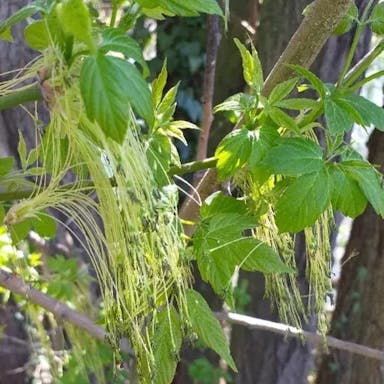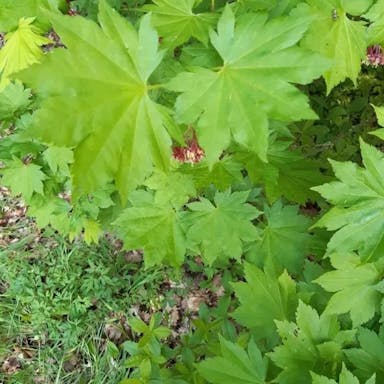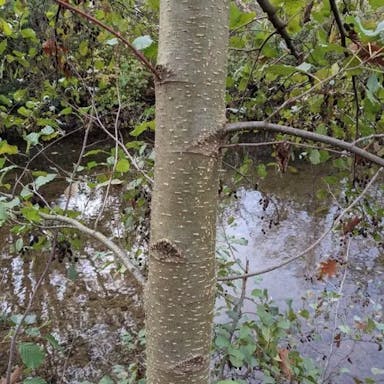For Grey alder, watering frequency varies depending on the season. During the growing season in spring and summer, water deeply once a week. Ensure the soil is consistently moist but not waterlogged. In winter, reduce watering to once every two weeks. Monitor soil humidity by checking the top few inches for dryness. Adjust watering amounts based on environmental conditions to maintain soil moisture levels. Avoid overwatering as it can lead to root rot. Adequate watering is crucial for Grey alder's health and growth.
Grey alder
- Scientific name
- Alnus incana
Basic Information
- Betulaceae Family Alnus Genus Grey alder Species
- Betulaceae > Alnus > Alnus incana
- 83%
- The Completeness of This Encyclopedia
Please help us complete the encyclopedia, Terrarium is a encyclopedia service to be completed with everyone in the world. Currently, this page is 83% complete. For more information on how to contribute, please click here.
- Broad-leaved tree
- Indeciduous tree
- Tree
- Height
- 1500cm ~
- Flower Color
- Leaf Color
- Anthesis
- spring
- Sunlight Exposure
Full Sun Long hours of sunlight from morning to afternoon Partial Shade A location in the shade of a tree or where either the morning or afternoon is shaded Full Shade A place where there is no direct sunlight
- Full Sun
- Hardiness Zones
This is an indicator to know to which zone each plant can winter. Knowing the zone of each plant gives you an idea of the cold temperature resistance when grown in the ground without a roof. 2: -42.7 to -40.0 3: -39.9 to -34.4 4: -34.3 to -28.9 5: -28.8 to -23.3 6: -23.2 to -17.8 7: -17.7 to -12.2 8: -12.1 to -6.7 9: -6.6 to -1.1 10: -1.0 to 4.4 11: 4.5 to 10.0
- 2
- Cold resistance
- Excellent
- Heat resistance
- Fair
- Habitat of origin
- Europe, Asia
- Growth Rate
- Fast
What is Grey alder (Alnus incana)?
What is Grey alder (Alnus incana)
Flower meaning
Grey alder thrives in full sun to partial shade, preferring at least 6 hours of direct sunlight daily. It exhibits good cold tolerance, able to withstand temperatures as low as -40°F (-40°C). Alder trees are less heat tolerant, preferring cooler climates and thriving in temperatures ranging from 60-75°F (15-24°C). During summer, adequate watering is crucial to prevent stress from heat. In winter, ensure proper drainage to prevent waterlogging. Placing Grey alder in well-drained soil is essential for its health. It can withstand a wide range of temperatures but prefers moderate conditions. Optimum sunlight exposure promotes healthy growth and foliage density. Aim for 6-8 hours of sunlight per day for optimal development.
Calendar of Grey alder (Alnus incana)
Calendar
Grey alder, scientifically known as Alnus incana, is a deciduous tree native to Europe, Asia, and North America. It belongs to the Betulaceae family and is characterized by its greyish bark and toothed leaves. The flowers of Alnus incana are catkins, with male and female catkins appearing on the same tree. The male catkins are yellow and pendulous, while the female catkins are smaller and green. The tree produces small, cone-like fruits that contain tiny seeds. Alnus incana can grow up to 20 meters in height and is relatively easy to cultivate in moist, well-drained soils. It is commonly used in landscaping and reforestation projects due to its ability to thrive in harsh conditions. There are several varieties of Alnus incana, including the subspecies Alnus incana subsp. rugosa, which is found in North America. The name "Alnus" is derived from the Latin word for alder, while "incana" refers to the greyish color of the tree's bark.
How to grow Grey alder (Alnus incana)
Watering
Grey alder thrives in moist, well-drained soils with a pH range of 5.0 to 7.5. It prefers sandy or loamy soils but can tolerate clay soils. Fertilize Grey alder with a balanced slow-release fertilizer in early spring before new growth begins. Apply fertilizer at a rate of 1 pound per inch of trunk diameter, spread evenly around the tree's drip line. Repeat this application annually for young trees. For mature trees, apply fertilizer every 2-3 years. Avoid fertilizing in late summer or fall to prevent new growth that may be damaged by frost. Monitor soil quality regularly to ensure optimal conditions for Grey alder's growth.
Soil and Fertilizer
Grey alder is best potted in well-draining soil to prevent waterlogging, promoting healthy root growth. Ensure the pot has drainage holes to prevent root rot and place it in a location with partial sunlight. When planting, gently loosen the roots and place the plant in the center of the pot at the same depth as it was in the nursery container. Fill the remaining space with soil, pressing lightly to remove air pockets. Repot every 2-3 years in a slightly larger container to accommodate root growth. Mist the leaves occasionally to increase humidity and prevent dust buildup.
Sunlight and Place
Grey alder benefits from regular pruning to maintain its shape, promote healthy growth, and prevent overcrowding. Pruning is best done during late winter or early spring before new growth appears. To prune Grey alder, remove any dead, damaged, or diseased branches first, followed by cutting back any crossing or rubbing branches. Additionally, thin out crowded areas to improve air circulation and light penetration. After pruning, make clean cuts just above a bud or lateral branch to encourage new growth. Regular pruning not only enhances the aesthetic appeal of Grey alder but also helps in preventing potential pest and disease issues.
Advanced Information of Grey alder (Alnus incana)
Pruning
Grey alder can be propagated through seeds, cuttings, and root division. Seeds should be sown in a well-draining soil mix in early spring. Cuttings can be taken from semi-hardwood in late summer and placed in a rooting hormone before planting. Root division is best done in early spring or fall by separating the roots and replanting them. To multiply using multiple methods, sow seeds for genetic diversity, take cuttings for quicker growth, and divide roots for faster establishment. Harvest seeds when they are mature and dry, cuttings when they have rooted, and divide roots when the plant is dormant.
Planting and Harvest
Grey alder is susceptible to various pests and diseases, including aphids, caterpillars, and leaf miners. These pests can cause damage by feeding on the leaves, leading to defoliation and reduced growth. Aphids can be controlled through natural predators like ladybugs or by spraying insecticidal soap. Caterpillars can be manually removed or treated with Bacillus thuringiensis. Leaf miners can be prevented by maintaining good plant hygiene and removing affected leaves promptly. Grey alder is also prone to diseases such as Phytophthora root rot and canker diseases. Phytophthora root rot is caused by a water mold and can be prevented by ensuring proper drainage and avoiding overwatering. Canker diseases are fungal infections that can be managed by pruning infected branches and promoting good air circulation within the canopy.
Propagation
Grey alder in the United States typically blooms in early spring, usually in the month of March. The flowers of Grey alder are at their best during this time, displaying their full beauty. The blooming period usually lasts for about 2-3 weeks, depending on environmental conditions. To extend the blooming time of Grey alder, ensure the plant receives adequate sunlight, water, and nutrients. Pruning dead or damaged branches can also promote more vigorous blooming. Additionally, avoiding excessive use of fertilizers high in nitrogen can help regulate blooming and prevent premature flower drop. Maintaining a healthy and well-balanced environment for Grey alder can enhance its blooming season and overall appearance.
Pests and Diseases
Grey alder seedlings should have well-developed roots and sturdy stems. Look for seeds that are plump and free of mold. Varieties like 'Imperialis' have striking purple leaves, while 'Laciniata' features deeply lobed foliage. 'Aurea' displays golden-yellow leaves, adding a vibrant touch to landscapes. Ensure seedlings are disease-free and not root-bound. Check for any signs of pests or discoloration. Select seeds that are fresh and viable for optimal germination. When choosing varieties, consider the desired aesthetic and growth characteristics. Research the specific requirements of each variety to ensure successful cultivation.
Habitat of Grey alder (Alnus incana)
Habitat
Toxicity of Grey alder (Alnus incana)
Health Benefits
- edible
- Inedible
- Toxic
- No toxicity
NO DATA
Toxic for dogs and cats
NO DATA












